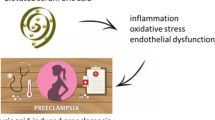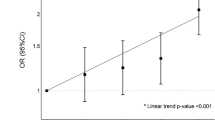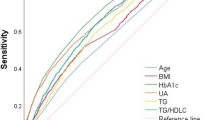Abstract
Higher serum levels of uric acid are associated with preeclampsia and may signal an early change in preeclampsia. However there is less evidence suggesting there is a meaningful association between uric acid and the development of preeclampsia. A total of 877 women with preeclampsia at presentation and 580 normotensive pregnancies were retrospectively recruited from January 2009 to May 2014. In addition, 5556 pregnant women were also prospectively recruited from September 2012 to December 2013. Retrospective serum levels of uric acid were obtained from women with preeclampsia at the time of presentation (n=877), and serum levels of uric acid in the first, second and third trimester were prospectively collected in women who later developed preeclampsia (n=78), as well as those who did not (n=5478). The serum levels of uric acid were significantly increased in women with preeclampsia at presentation from retrospective samples and this increase correlated with the time of onset and the severity of preeclampsia. However, in prospective samples, serum levels of uric acid were not increased in the first and second trimesters in women who later developed preeclampsia compared with those who did not. The serum level of uric acid in the first and second trimesters in women who developed preeclampsia was not different. Our results demonstrate that the serum levels of uric acid were only increased after the presentation of clinical symptoms of preeclampsia. Therefore, it is likely that uric acid is not involved in the development of preeclampsia and cannot be an early prediction biomarker of this disease.
This is a preview of subscription content, access via your institution
Access options
Subscribe to this journal
Receive 12 digital issues and online access to articles
$119.00 per year
only $9.92 per issue
Buy this article
- Purchase on Springer Link
- Instant access to full article PDF
Prices may be subject to local taxes which are calculated during checkout
Similar content being viewed by others
References
Sibai B, Dekker G, Kupferminc M . Pre-eclampsia. Lancet 2005; 365 (9461): 785–799.
Roberts J, Taylor R, Musci T, Rodgers G, Hubel C, McLaughlin M . Preeclampsia: an endothelial cell disorder. Am J Obstet Gynecol 1989; 161 (5): 1200.
Redman CW, Sargent IL . Latest advances in understanding preeclampsia. Science 2005; 308 (5728): 1592–1594.
Paula LG, da Costa BE, Poli-de-Figueiredo CE, Antonello IC . Does uric acid provide information about maternal condition and fetal outcome in pregnant women with hypertension? Hypertens Pregnancy 2008; 27 (4): 413–420.
Khosla UM, Zharikov S, Finch JL, Nakagawa T, Roncal C, Mu W et al. Hyperuricemia induces endothelial dysfunction. Kidney Int 2005; 67 (5): 1739–1742.
Doehner W, Schoene N, Rauchhaus M, Leyva-Leon F, Pavitt DV, Reaveley DA et al. Effects of xanthine oxidase inhibition with allopurinol on endothelial function and peripheral blood flow in hyperuricemic patients with chronic heart failure: results from 2 placebo-controlled studies. Circulation 2002; 105 (22): 2619–2624.
Stillman IE, Karumanchi SA . The glomerular injury of preeclampsia. J Am Soc Nephrol 2007; 18 (8): 2281–2284.
Stratta P, Canavese C, Colla L, Dogliani M, Bussolino F, Bianco O et al. Acute renal failure in preeclampsia-eclampsia. Gynecol Obstet Invest 1987; 24 (4): 225–231.
Assali NS, Kaplan SA, Fomon SJ, Douglass RA Jr. . Renal function studies in toxemia of pregnancy; excretion of solutes and renal hemodynamics during osmotic diuresis in hydropenia. J Clin Invest 1953; 32 (1): 44–51.
McCartney CP, Spargo B, Lorincz AB, Lefebvre Y, Newton RE . Renal structure and function in pregnant patients with acute hypertension; osmolar concentration. Am J Obstet Gynecol 1964; 90: 579–592.
Sarles HE, Hil SS, LeBlanc AL, Smith GH, Canales CO, Remmers AR Jr . Sodium excretion patterns during and following intravenous sodium chloride loads in normal and hypertensive pregnancies. Am J Obstet Gynecol 1968; 102 (1): 1–7.
Moran P, Baylis PH, Lindheimer MD, Davison JM . Glomerular ultrafiltration in normal and preeclamptic pregnancy. J Am Soc Nephrol 2003; 14 (3): 648–652.
Pollak VE, Nettles JB . The kidney in toxemia of pregnancy: a clinical and pathologic study based on renal biopsies. Medicine (Baltimore) 1960; 39: 469–526.
Boyle JA, Campbell S, Duncan AM, Greig WR, Buchanan WW . Serum uric acid levels in normal pregnancy with observations on the renal excretion of urate in pregnancy. J Clin Pathol 1966; 19 (5): 501–503.
Slemons JM, Bogert LJ . The uric acid content of maternal and fetal blood. J Biol Chem 1917; 32 (1): 63–69.
Martin AC, Brown MA . Could uric acid have a pathogenic role in pre-eclampsia? Nat Rev Nephrol 2010; 6 (12): 744–748.
Powers RW, Bodnar LM, Ness RB, Cooper KM, Gallaher MJ, Frank MP et al. Uric acid concentrations in early pregnancy among preeclamptic women with gestational hyperuricemia at delivery. Am J Obstet Gynecol 2006; 194 (1): 160.
Bainbridge SA, Roberts JM . Uric acid as a pathogenic factor in preeclampsia. Placenta 2008; 29 (Suppl A): S67–S72.
Hawkins TL, Roberts JM, Mangos GJ, Davis GK, Roberts LM, Brown MA . Plasma uric acid remains a marker of poor outcome in hypertensive pregnancy: a retrospective cohort study. BJOG 2012; 119 (4): 484–492.
Roberts JM, Bodnar LM, Lain KY, Hubel CA, Markovic N, Ness RB et al. Uric acid is as important as proteinuria in identifying fetal risk in women with gestational hypertension. Hypertension 2005; 46 (6): 1263–1269.
Koopmans CM, van Pampus MG, Groen H, Aarnoudse JG, van den Berg PP et al. Accuracy of serum uric acid as a predictive test for maternal complications in pre-eclampsia: bivariate meta-analysis and decision analysis. Eur J Obstet Gynecol Reprod Biol 2009; 146 (1): 8–14.
von Dadelszen P, Magee LA, Roberts JM . Subclassification of preeclampsia. Hypertens Pregnancy 2003; 22 (2): 143–148.
Schroeder BM . ACOG practice bulletin on diagnosing and managing preeclampsia and eclampsia. American College of Obstetricians and Gynecologists. Am Fam Physician 2002; 66 (2): 330–331.
Hypertension in Pregnancy. American College of Obstetricians and Gynecologists. Women's Health Care Physician, November 2013.
Winocour PH, Taylor RJ . Early alterations of renal function in insulin-dependent diabetic pregnancies and their importance in predicting pre-eclamptic toxaemia. Diabetes Res 1989; 10 (4): 159–164.
Wu Y, Xiong X, Fraser WD, Luo ZC . Association of uric acid with progression to preeclampsia and development of adverse conditions in gestational hypertensive pregnancies. Am J Hypertens 2012; 25 (6): 711–717.
Laughon SK, Catov J, Powers RW, Roberts JM, Gandley RE . First trimester uric acid and adverse pregnancy outcomes. Am J Hypertens 2011; 24 (4): 489–495.
Kang DH, Finch J, Nakagawa T, Karumanchi SA, Kanellis J, Granger J et al. Uric acid, endothelial dysfunction and pre-eclampsia: searching for a pathogenetic link. J Hypertens 2004; 22 (2): 229–235.
Tsukimori K, Yoshitomi T, Morokuma S, Fukushima K, Wake N . Serum uric acid levels correlate with plasma hydrogen peroxide and protein carbonyl levels in preeclampsia. Am J Hypertens 2008; 21 (12): 1343–1346.
Gulmezoglu AM, Hofmeyr GJ, Oosthuisen MM . Antioxidants in the treatment of severe pre-eclampsia: an explanatory randomised controlled trial. Br J Obstet Gynaecol 1997; 104 (6): 689–696.
Xiao J, Shen F, Xue Q, Chen G, Zeng K, Stone P et al. Is ethnicity a risk factor for developing preeclampsia? An analysis of the prevalence of preeclampsia in China. J Hum Hypertens 2014; 28 (11): 694–698.
Redman CW, Beilin LJ, Bonnar J, Wilkinson RH . Plasma-urate measurements in predicting fetal death in hypertensive pregnancy. Lancet 1976; 1 (7974): 1370–1373.
Williams KP, Galerneau F . The role of serum uric acid as a prognostic indicator of the severity of maternal and fetal complications in hypertensive pregnancies. J Obstet Gynaecol Can 2002; 24 (8): 628–632.
Weerasekera DS, Peiris H . The significance of serum uric acid, creatinine and urinary microprotein levels in predicting pre-eclampsia. J Obstet Gynaecol 2003; 23 (1): 17–19.
Homer CS, Brown MA, Mangos G, Davis GK . Non-proteinuric pre-eclampsia: a novel risk indicator in women with gestational hypertension. J Hypertens 2008; 26 (2): 295–302.
Urato AC, Bond B, Craigo SD, Norwitz ER, Paulus JK, Strohsnitter WC . Admission uric acid levels and length of expectant management in preterm preeclampsia. J Perinatol 2012; 32 (10): 757–762.
Nakagawa T, Hu H, Zharikov S, Tuttle KR, Short RA, Glushakova O et al. A causal role for uric acid in fructose-induced metabolic syndrome. Am J Physiol Renal Physiol 2006; 290 (3): F625–F631.
Acknowledgements
This study was supported by the Chinese National Nature Sciences Foundation (grant number 81100437 to MZ). We thank all the women who donated blood for this study. We thank Dr Joanna James from The University of Auckland for editing this manuscript.
Author information
Authors and Affiliations
Corresponding author
Ethics declarations
Competing interests
The authors declare no conflict of interest.
Rights and permissions
About this article
Cite this article
Chen, Q., Lau, S., Tong, M. et al. Serum uric acid may not be involved in the development of preeclampsia. J Hum Hypertens 30, 136–140 (2016). https://doi.org/10.1038/jhh.2015.47
Received:
Revised:
Accepted:
Published:
Issue Date:
DOI: https://doi.org/10.1038/jhh.2015.47
This article is cited by
-
Association of first trimester serum uric acid with preeclampsia: an observational cohort study with propensity score matching
Hypertension Research (2023)
-
An elevation in serum uric acid precedes the development of preeclampsia
Hypertension Research (2023)
-
Serum uric acid levels associated with biochemical parameters linked to preeclampsia severity and to adverse perinatal outcomes
Archives of Gynecology and Obstetrics (2022)
-
The Role of Uric Acid in Preeclampsia: Is Uric Acid a Causative Factor or a Sign of Preeclampsia?
Current Hypertension Reports (2018)



